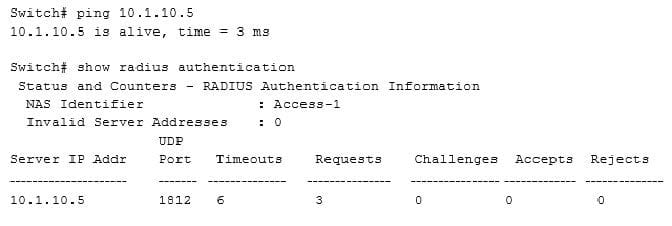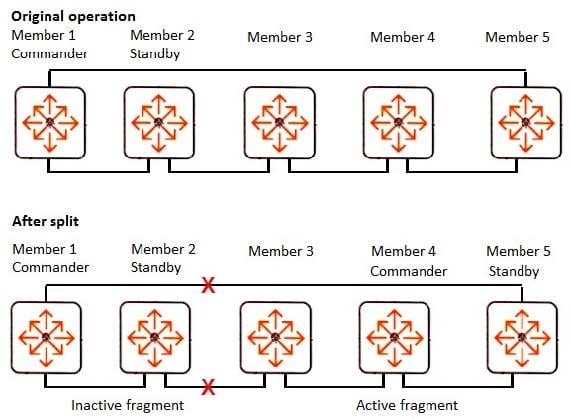Exam Details
Exam Code
:HPE6-A45Exam Name
:Implementing Aruba Campus Switching solutionsCertification
:HP CertificationsVendor
:HPTotal Questions
:168 Q&AsLast Updated
:Mar 22, 2025
HP HP Certifications HPE6-A45 Questions & Answers
-
Question 31:
Refer to the exhibit.

The routing switches shown in the exhibit use OSPF, and all of their interfaces are in Area 1. A faulty link on Switch-1 went up and down many times over the course of several hours. This caused link state updates (LSUs) to flood all of the routing devices in the OSPF AS and reduce performance. The network administrator fixed the faulty link on Switch-1, but the administrator also wants to mitigate the effects if a similar issue occurs in the future.
Which design improvement would help?
A. Configure Area 1 as a stub area on all routers except Switch-2, Switch-3, and Switch-4
B. Divide the AS into different areas, and aggregate routes between them
C. Divide the AS into different areas, and configure the backbone area as an NSSA
D. Decrease the LSA generation timer, and make sure to set the same value on all routers
-
Question 32:
A network administrator enters this command on an AOS-Switch:
Switch(config)# radius-server host 10.1.3.3 time-window 60
Which behavior will the switch show?
A. It will wait one minute for a response from the RADIUS server before it sends another message
B. It will reject RADIUS server change of authorization (CoA) messages with timestamps that are more than one minute old
C. It will maintain idle user sessions for one minute before it re-authenticates the user to the RADIUS server
D. It will give supplicants up to one minute to respond to RADIUS challenges before it considers authentication failed
-
Question 33:
AOS-Switches authenticate guests to ClearPass with captive portal. When guests first connect their device to the network, they are redirected to a captive portal in which they log in. ClearPass then stores the guest MAC addresses, and the guests are permitted access. Due to a conflict, the network administrator needs to change the dynamic authorization port, port 3799 on Aruba ClearPass.
If the administrator forgets to also change the port on one of the AOS-Switches, what will be one symptom?
A. Some guests receive full access to the network when they first connect instead of being redirected to the portal page
B. When some guests successfully authenticate in the captive portal, they are redirected back to the portal page
C. Guests are redirected to the system listening on port 3799
D. Some guests are unable to reach the captive portal page. Instead, they receive no access at all
-
Question 34:
A customer wants access layer switches that support routing. ACLs, VSF stacking, and SFP+.
Which Aruba switch model meets the customer's requirements?
A. 2530
B. 2930F
C. 3810
D. 8400
-
Question 35:
Refer to the exhibit.

A network administrator sets up 802.1X authentication to a RADIUS server on an AOS-Switch. The RADIUS server and user devices are both set up to use PEAP MSCHAPv2. The administrator tests the authentication and sees the output shown in the exhibit.
Which issue could cause this output?
A. The administrator entered the wrong password for the test account
B. The RADIUS shared secret does not match on the switch and the server
C. The switch does not have a certificate for port-access installed on the switch
D. The switch port is set for user mode 802.1X, but the RADIUS server is set for port mode
-
Question 36:
A network administrator configures VSF settings on two Aruba 2930F switches. The switches form two separate VSF fabrics.
What should the administrator check?
A. that the domain ID matches on both switches
B. that each switch is assigned a unique VSF priority
C. that LLDP MAD is configured on both members
D. that the switch with the lower priority has the lower member ID
-
Question 37:
A network administrator needs to find the source of a performance issue. The administrator has seen that interfaces sometimes start to drop many packets, but the issue is intermittent, and the administrator is not sure exactly when it happens. The administrator wants to be alerted when interfaces start to drop packets. The switches already have an SNMP trap server configured on them.
What else should an administrator do on these switches?
A. Enable link change SNMP traps on the switch
B. Set up RMON alarms on dropped packet statistics
C. Set the trap server to inform mode
D. Enable debugging to the session
-
Question 38:
A network administrator needs to control traffic based on Ethertype and Class of Service. What should the administrator configure for this purpose?
A. both a standard IP ACL and a standard MAC ACL
B. both a standard IP ACL and an extended MAC ACL
C. an extended IP ACL only
D. an extended MAC ACL only
-
Question 39:
AOS-Switch runs IGMP in data-driven mode. What behavior does it exhibit?
A. It drops multicasts destined to groups that have no members
B. It preempts the querier role even if another device has higher priority
C. It floods multicasts on all ports in the VLAN if the group has at least one member
D. It disables automatic fast leave on ports that connect to a single device
-
Question 40:
Refer to the exhibit.

An administrator created a backplane stack with the plug-and-play method and did not after the default backplane stacking settings. Later, who backplane stacking links failed as shown in the exhibit. The network administrator then restored the failed links.
When the stack is reformed, which switches become commander and standby?
A. Member 4 remains commander, and Member 5 remains standby
B. Member 1 becomes commander, and Member 4 becomes standby
C. Member 4 remains commander, and Member 1 becomes standby
D. Member 1 becomes commander, and Member 2 becomes standby
Related Exams:
HP0-D15
Administering HP CloudSystem Matrix SolutionsHP0-D20
Architecting the HP Matrix Operating EnvironmentHP2-E56
Selling HP SMB SolutionsHP2-H88
Selling HP Business Personal Systems Hardware 2019HP2-I14
Selling HP Supplies 2020HP2-I15
Selling HP Business Personal Systems Hardware 2020HP2-I17
Selling HP Printing Hardware 2020HP2-I44
Selling HP Workstations 2022HP2-I73
Selling HP Retail and Hospitality Solutions 2024HP2-N51
HP Application Lifecycle Management 12.x Software
Tips on How to Prepare for the Exams
Nowadays, the certification exams become more and more important and required by more and more enterprises when applying for a job. But how to prepare for the exam effectively? How to prepare for the exam in a short time with less efforts? How to get a ideal result and how to find the most reliable resources? Here on Vcedump.com, you will find all the answers. Vcedump.com provide not only HP exam questions, answers and explanations but also complete assistance on your exam preparation and certification application. If you are confused on your HPE6-A45 exam preparations and HP certification application, do not hesitate to visit our Vcedump.com to find your solutions here.